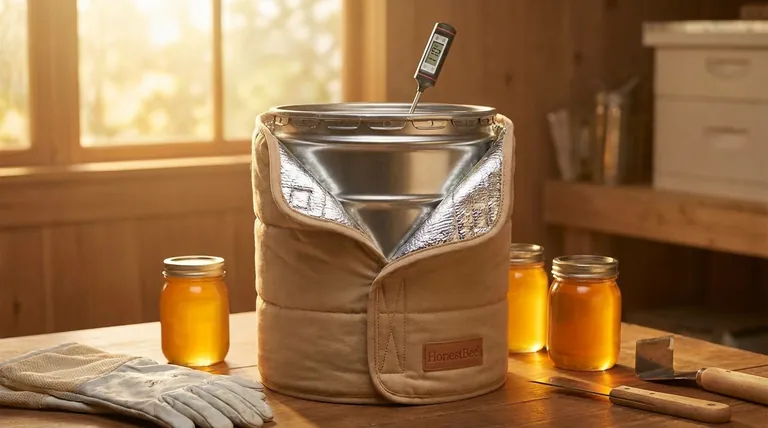At its core, the Bee Blanket is designed to warm and maintain honey at an ideal temperature of 110°F. This target temperature has a built-in tolerance, allowing it to operate within a range of approximately 100°F to 120°F. The goal is to gently warm the honey, making it easier to handle without damaging its natural properties.
The central challenge with honey is managing its viscosity without compromising its quality. The Bee Blanket solves this by maintaining a consistent, hive-like temperature that liquefies crystallized honey while preserving its beneficial enzymes and nutrients.

Why Temperature Control is Critical for Honey
Honey is a delicate natural product. Its consistency and chemical composition are highly sensitive to heat. Applying too much heat too quickly can permanently alter its quality.
Emulating the Natural Hive Environment
The target temperature of 110°F (approximately 43°C) is not arbitrary. It's chosen to mimic the upper range of temperatures found naturally within a beehive.
This gentle, low-and-slow heating approach ensures the honey is warmed evenly, preventing "hot spots" that can scorch the honey and destroy its delicate flavors and aromas.
The Problem with Crystallization
Crystallization is a natural process where the glucose in honey separates from water, forming solid crystals. This makes the honey thick, grainy, and difficult to extract from its container.
Applying gentle heat is the most effective way to reverse this process. The Bee Blanket's consistent temperature melts these crystals, returning the honey to a smooth, liquid state.
Preserving Quality and Nutrients
The most important reason for precise temperature control is the preservation of honey's natural enzymes and beneficial compounds.
Aggressive heating methods, such as using a microwave or direct stovetop heat, can easily exceed 120°F. This can "cook" the honey, destroying valuable enzymes like diastase and invertase and diminishing its overall quality. The Bee Blanket is specifically engineered to avoid this.
Understanding the Trade-offs of Heating Honey
While heating is necessary for processing crystallized honey, it's a process that requires careful management. The primary goal is always to use the minimum effective temperature.
Efficiency vs. Quality
The main trade-off is between speed and quality. Higher temperatures would liquefy the honey faster, but at the significant risk of overheating and damage.
The Bee Blanket prioritizes quality over speed. It is intentionally designed for a slower, more even warming process to ensure the honey's integrity is never compromised.
The Risk of Overheating
Pushing the temperature beyond the 120°F threshold leads to negative consequences. The honey's flavor profile can change, its color can darken, and its nutritional value can be significantly reduced.
By maintaining a steady temperature well below this danger zone, the blanket provides a reliable and safe method for beekeepers and processors to handle their product.
Making the Right Choice for Your Honey
The Bee Blanket's temperature profile is designed to meet a specific need within honey processing. Understanding your goal is key to using it effectively.
- If your primary focus is liquefying crystallized honey: The 110°F target temperature is ideal for melting crystals and restoring a smooth consistency without damaging the product.
- If your primary focus is preserving raw honey's enzymes: This controlled, hive-like temperature is specifically designed to keep the honey's beneficial properties intact.
- If your primary focus is preparing honey for bottling or extraction: Maintaining this temperature keeps the honey's viscosity low, making it flow easily for filtering and packaging.
Ultimately, the Bee Blanket provides a controlled, reliable method to gently warm honey, ensuring it remains as close to its natural state as possible.
Summary Table:
| Feature | Specification | Key Benefit |
|---|---|---|
| Target Temperature | 110°F (43°C) | Mimics the natural hive environment for gentle warming |
| Operating Range | 100°F - 120°F | Built-in tolerance ensures safety and prevents overheating |
| Primary Function | Gentle, even heating | Liquefies crystallized honey while preserving delicate enzymes and flavor |
Protect Your Honey's Quality with the Right Equipment
Are you a commercial apiary or beekeeping equipment distributor looking for a reliable, wholesale-focused partner? The Bee Blanket is just one example of our commitment to quality beekeeping supplies. HONESTBEE provides durable, effective equipment designed to help you manage your honey harvest efficiently while preserving its natural value.
Contact HONESTBEE today to discuss your wholesale needs and discover how our supplies can support your operation's success.
Visual Guide

Related Products
- Professional Thermostatic Conical Honey Melter
- Honey Concentrating Vacuum Heating Thickening Machine Dehumidifier for Honey
- High Quality Honey Dehumidifier Dryer Thickening Machine for Beekeeping
- 0.5T Capacity Honey Dehumidifier Dryer with Vacuum Heating and Thickening Filtering Machine
- Economy Small Scale Honey Dryer Dehumidifier Thickening Machine
People Also Ask
- Is it safe to heat crystallized honey? Restore Your Honey's Liquid State Safely
- Why is heating honey sometimes necessary? The Essential Guide to Processing & Quality
- How to permanently decrystallize honey? Embrace Its Natural State for Maximum Quality
- What equipment is commonly used for heating and processing honey? Essential Tools for Every Beekeeper
- What is melter honey used for? A Low-Cost Ingredient for Bakers and Brewers



















